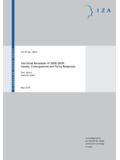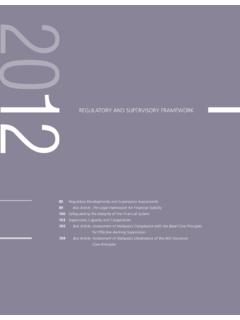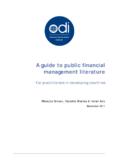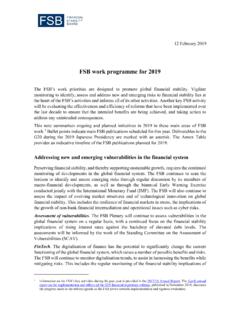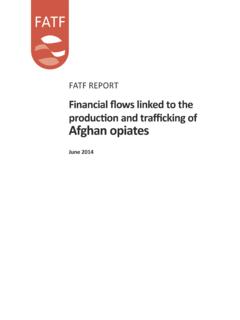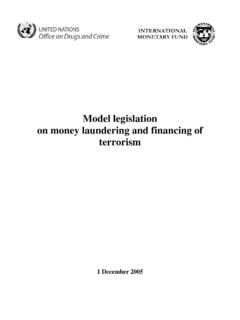Transcription of Discussant remarks on Filipa Sá, Pascal Towbin and Tomasz ...
1 BIS Papers No 64 75 Discussant remarks on Filipa S , Pascal Towbin and Tomasz Wieladek s paper capital inflows , financial innovation and housing booms Kenneth N Kuttner1 1. Introduction Since the global financial crisis of 2007 09, economists and policymakers have struggled to understand the causes of asset price booms and busts. The challenge is illustrated in Figure 1, which shows the path of real property prices from 2000 through 2010 for seven advanced economies (Austria, Canada, Denmark, Ireland, Norway, the United Kingdom and the United States). One question is why property prices in all seven of these countries (and many more besides) all rose and fell over roughly the same period. Was a common factor at work across countries, and if so, what was it? The second question is why the size of the boom differed across countries.
2 What explains the fact that house prices doubled in the United Kingdom, but appreciated only slightly in Austria? This paper presents an empirical analysis of these difficult questions, paying particular attention to the effects of interest rates, capital flows, and financial structure. A large number of papers have analysed the effects of each of these factors individually, but this is the first that I am aware of that examines all three in a single empirical framework. 2. Summary of the model The analysis employs a state-of-the-art partially identified 12-variable panel vector autoregression (VAR) for 18 OECD countries. Monetary policy and capital flows are modelled as structural shocks, identified via sign restrictions. Specifically, the identification scheme assumes that monetary policy shocks have the standard macroeconomic effects: expansions increase consumption, investment and inflation and lead to a real depreciation.
3 Similarly, capital inflows increase consumption and investment and lead to a real appreciation, while reducing the long-term interest rate. The paper takes two complementary approaches to assessing the impact of financial structure. One is to split the sample according to the level of financial market development, measured by an IMF index of mortgage market sophistication. The other is to interact an index measuring the prevalence of mortgage securitisation with a subset of the VAR coefficients. The authors approach is eminently reasonable. The panel VAR method allows them to estimate an extremely rich model while imposing just enough structure to allow for a sensible economic interpretation. I would be hard-pressed to improve on their method, but I nonetheless have two reservations. One is that while the identification scheme yields impulse responses with the desired signs, the dynamics are implausible.
4 An expansionary monetary policy shock, for example, causes 1 Robert F White Class of 1952 Professor of Economics, Department of Economics, Williams College. 76 BIS Papers No 64 an immediate jump in the price level. This is in marked contrast to conventional monetary VARs, such as those reported in Christiano et al. (1999), in which the inflation response is quite sluggish, rising gradually over a period of one to two years. A second point is that the identification strategy allows for the identification of only two structural shocks. This is both a strength and a weakness. The strength is that it minimises the assumptions needed to obtain results for the two structural shocks of interest, and indeed a very large number of restrictions would be required to fully identify a 12-variable system.
5 But it is also a limitation to the extent that it does not allow the impact of other structural shocks to be estimated. The analysis is therefore silent on the other contributors to real estate price fluctuations. 3. The main findings Like most VAR analyses, the paper s results are presented in terms of the impulse response functions and variance decompositions. The findings are reassuring: the estimated responses are statistically significant, and the signs are consistent with theoretical priors. With regard to monetary policy shocks, the baseline model estimates show that a 25 basis point monetary policy shock causes a change in house prices at a horizon of roughly two years, gradually diminishing after that. The variance decompositions indicate that monetary policy shocks account for of house price variance at the three-year horizon.
6 The results also reveal a link between the current account balance and property prices. A one-standard-deviation current account shock causes a change in house prices, and the shocks account for of house price variance at the three-year horizon. One important implication is that expansionary monetary policy must have played a minor role in the past decade s property price bubble, contrary to Taylor s (2009) assertion. Taking the paper s finding at face value, a huge 200 basis point expansionary shock would have led to only a house price appreciation, far less than the observed double-digit increases. The small size of the interest rate effects are consistent with those reported by a number of other recent papers, including those of Jaroci ski and Smets (2008), Dokko et al. (2009), and Glaeser et al. (2010). With a somewhat larger share of the variance decomposition, current account shocks may have played a somewhat more important role in the bubble, and the paper makes a valuable contribution in highlighting this channel.
7 Even so, a inflow (a one in 25 year event) would have resulted in an appreciation of only The role of mortgage market sophistication is discernable but modest. In countries that score high on the IMF mortgage market development index, a 25 basis point monetary policy shock causes a roughly change, compared with for those with unsophisticated markets; the shares of house price variance attributable to monetary policy shocks at the three-year horizon are and , respectively. The difference for capital flow shocks is comparable: a peak response of for countries with sophisticated mortgage markets, versus for those with less developed markets, and variance contributions of and , respectively. 4. Interpreting the responses to monetary policy shocks As noted in the paper s introduction, a number of theories are capable of explaining the response of property prices (and asset prices more generally) to interest rates.
8 The most basic is the venerable and much-maligned user cost (UC) model. Some have suggested that BIS Papers No 64 77 credit and risk-taking channels are also operative. All three models deliver an inverse relationship between the interest rate and the property price, which is qualitatively consistent with the paper s findings on the effects of monetary policy shocks. Of course, one would also like to know whether the results were quantitatively consistent with these models implications. A natural question to ask in this context is whether the standard UC model can explain the magnitude of the estimated interest rate response. If not, then one would need to appeal to some additional effect, like those implied by the credit and risk-taking channels. The quantitative implications of the UC model are easy to work out, thanks to its direct link between the interest rate and the property price.
9 The model is based on the assumption that people should be indifferent on the margin between renting and owning. The relationship is embodied in an equation linking the rent-to-price ratio, R/P, to the user cost, RtPt UCt (i tP)(1 tY) te where i is the relevant interest rate, P is the property tax rate, Y is the income tax rate, is the rate of physical depreciation, and e is the expected rate of property price appreciation. Naturally, given the imperfections and frictions in both the rental and owner-occupied markets, it is unrealistic to expect that this relationship would hold at every moment in time. It is nevertheless a useful benchmark for assessing the likely magnitude of the interest rate effects. The basic UC equation can be differentiated to obtain the elasticity of the house price with respect to the interest rate holding rent constant, dPdiiP i(1 Y)(i P)(1 Y) e In the absence of taxes and depreciation and with e = 0, the elasticity is 1; for plausible values of P, Y and , the elasticity is roughly Armed with this relationship, it is straightforward to calculate the UC-implied contribution of low interest rates to the housing boom in the United States.
10 As shown in Figure 2, the rent-to-price ratio fell by 25% from 2001 to 2005, mostly driven by the steep increase in house prices. Over the same period, the real UC fell from roughly 6% to 5%, a decline of one percentage point, or 18%. Using an elasticity of , the UC reduction should have led to a drop in the rent-to-price ratio, roughly half of the observed decline. The UC model therefore goes a long way towards explaining rising property values during the boom period. Relative to this benchmark, the paper s VAR model delivers a much smaller estimate of the interest rates contribution. Specifically, given the link between long- and short-term interest rates, the VAR results suggest that roughly ten 25-basis-point expansionary monetary policy shocks would have been required to produce a one percentage point reduction in the long-term interest rate observed in the data.










